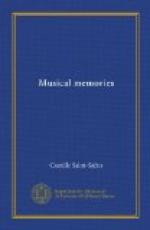This is the sort of work of which the public remains in ignorance and which it ought to know.
But all this is not what I started out to say. I wanted to write about a delicate, touching, reserved and precious work by the same author—The Seven Words of Christ on the Cross. This work has appeared in three forms—for an orchestra and chorus, for an orchestra alone, and for a quartet. When I was a young man, they used to say in Paris that this work was originally written for a quartet, then developed for an orchestra, and, finally, the voices were added.
Chance took me to Cadiz, once upon a time, and there I was given the true story of this beautiful piece of work. To my astonishment I learned that it had been first performed in the city of Cadiz. They even spoke of a competition in which Haydn won the prize, but there was never any such contest. The work was ordered from the author, but the question is who ordered it. Two religious circles, the Cathedral and the Cueva del Rosario, both lay claim to the initiative. I have gone over all the evidence in this dispute which is of little interest to us, for the only interest is the origin of the composition. There is not the slightest doubt that the Seven Words was written in the first place for an orchestra in 1785, and its destination, as we shall see, was settled by the author himself.
In his Memoires pour la Biographie et la Bibliographie de l’ile de Cadix, Don Francisco de Miton, Marquis de Meritos, relates that he corresponded with Haydn and ordered this composition which was to be performed at the Cathedral in Cadiz. According to his account Haydn said that “the composition was due more to what Senor Milton wrote than to his own invention, for it showed every motif so marvellously that on reading the instructions he seemed to read the music itself.”
If the Marquis was not boasting, we must confess that the ingenuous Haydn was not so ingenuous as has been thought, and that he knew how to flatter his patrons.
In 1801 Breitkopf and Haertel published the work with the addition of the vocal parts at Leipzig. This edition had a preface by the author in which he said:
About fifteen years ago, a cure at Cadiz engaged me to write some passages of instrumental music on the Seven Words of Christ on the Cross. It was the custom at that time to play an oratorio at the Cathedral during Holy Week, and they took great pains to give as much solemnity as possible. The walls, the windows and the pillars of the church were hung in black, and only a single light in the centre shone in the sanctuary. The doors were closed at mid-day and the orchestra began to play. After the opening ceremonies the bishop entered the pulpit, pronounced one of the “Seven Words” and delivered a few words inspired by it. Then he descended, knelt before the altar, and remained there for some time. This pause was relieved by the music.




